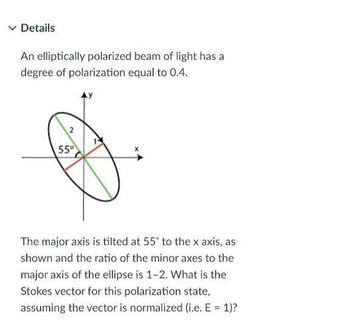
College Physics
11th Edition
ISBN: 9781305952300
Author: Raymond A. Serway, Chris Vuille
Publisher: Cengage Learning
expand_more
expand_more
format_list_bulleted
Question

Transcribed Image Text:✓ Details
An elliptically polarized beam of light has a
degree of polarization equal to 0.4.
55°
The major axis is tilted at 55° to the x axis, as
shown and the ratio of the minor axes to the
major axis of the ellipse is 1-2. What is the
Stokes vector for this polarization state,
assuming the vector is normalized (i.e. E= 1)?
Expert Solution
This question has been solved!
Explore an expertly crafted, step-by-step solution for a thorough understanding of key concepts.
This is a popular solution
Trending nowThis is a popular solution!
Step by stepSolved in 4 steps

Knowledge Booster
Learn more about
Need a deep-dive on the concept behind this application? Look no further. Learn more about this topic, physics and related others by exploring similar questions and additional content below.Similar questions
- If the direction E in space 1 is given as shown below and the magnitude E, = 5 volt. Find E, in space 2 and the measure of angle a, If ɛ1, = 3,1; ɛ2r = 5; and 0 = 45°. aarrow_forwardIt’s a sunny Saturday afternoon and you are walking around the lake by your house, enjoying the last few days of summer. The sidewalk surrounding the perimeter of the circular lake is crowded with walkers and runners. You then notice a runner approaching you wearing a T-shirt with writing on it. You read the first two lines, but are unable to read the third line before he passes. You wonder, ”Hmmm, if he continues around the lake, I bet I’ll see him again but I should anticipate the time when we’ll pass again.” You look at your watch and it is 5:07pm. You estimate your walking speed at 3 m/s and the runner’s speed to be about 14 m/s. You also estimate that the diameter of the lake is about 2 miles. At what time should you expect to read the last line of the t-shirt?arrow_forwardTo study Brownian motion, Bob, a student at the University of Ottawa, used his camera to capture the positions (i.e. displacements) of 50 microscopic dust particles floating on the surface of the water of his aquarium. By setting his camera to record 10 frames per second and noting down each particle's 2D displacement for each recorded frame, he managed to obtain the following mean-displacement vs time graph: 1600 1400 1200 2 1000 V 800 600 400 200 20 40 60 80 100 120 140 Time (s) a. Use the above mean-displacement graph to roughly approximate the diffusion coefficient D of the dust particles with units of um? /s. b. From the diffusion coefficient estimate in a), calculate the root mean- square displacement expected between each consecutive frame? c. Are the diffusion coefficient D and mean-square displacement calculated reasonable for a microscopic particle, or did Bob make a mistake in his calculations? Mean-square disp. (cm²)arrow_forward
- ū u = (4, -2) Find the direction angle of u. Enter your answer as an angle in degrees between 0° and 360° rounded to the nearest hundredth. 0 =arrow_forwardFor an independent study project, you design an experiment to measure the speed of light. You propose to bounce laser light off a mirror that is 54.5 km due east and have it detected by a light sensor that is 115 m due south of the laser. The first problem is to orient the mirror so that the laser light reflects off the mirror and into the light sensor. (a) Determine the angle that the normal to the mirror should make with respect to due west. °(b) Since you can read your protractor only so accurately, the mirror is slightly misaligned and the actual angle between the normal to the mirror and due west exceeds the desired amount by 0.003°. Determine how far south you need to move the light sensor in order to detect the reflected laser light. marrow_forwardShown is the v vs. t curve. What is the area A of the shaded region under the curve?arrow_forward
arrow_back_ios
arrow_forward_ios
Recommended textbooks for you
 College PhysicsPhysicsISBN:9781305952300Author:Raymond A. Serway, Chris VuillePublisher:Cengage Learning
College PhysicsPhysicsISBN:9781305952300Author:Raymond A. Serway, Chris VuillePublisher:Cengage Learning University Physics (14th Edition)PhysicsISBN:9780133969290Author:Hugh D. Young, Roger A. FreedmanPublisher:PEARSON
University Physics (14th Edition)PhysicsISBN:9780133969290Author:Hugh D. Young, Roger A. FreedmanPublisher:PEARSON Introduction To Quantum MechanicsPhysicsISBN:9781107189638Author:Griffiths, David J., Schroeter, Darrell F.Publisher:Cambridge University Press
Introduction To Quantum MechanicsPhysicsISBN:9781107189638Author:Griffiths, David J., Schroeter, Darrell F.Publisher:Cambridge University Press Physics for Scientists and EngineersPhysicsISBN:9781337553278Author:Raymond A. Serway, John W. JewettPublisher:Cengage Learning
Physics for Scientists and EngineersPhysicsISBN:9781337553278Author:Raymond A. Serway, John W. JewettPublisher:Cengage Learning Lecture- Tutorials for Introductory AstronomyPhysicsISBN:9780321820464Author:Edward E. Prather, Tim P. Slater, Jeff P. Adams, Gina BrissendenPublisher:Addison-Wesley
Lecture- Tutorials for Introductory AstronomyPhysicsISBN:9780321820464Author:Edward E. Prather, Tim P. Slater, Jeff P. Adams, Gina BrissendenPublisher:Addison-Wesley College Physics: A Strategic Approach (4th Editio...PhysicsISBN:9780134609034Author:Randall D. Knight (Professor Emeritus), Brian Jones, Stuart FieldPublisher:PEARSON
College Physics: A Strategic Approach (4th Editio...PhysicsISBN:9780134609034Author:Randall D. Knight (Professor Emeritus), Brian Jones, Stuart FieldPublisher:PEARSON

College Physics
Physics
ISBN:9781305952300
Author:Raymond A. Serway, Chris Vuille
Publisher:Cengage Learning

University Physics (14th Edition)
Physics
ISBN:9780133969290
Author:Hugh D. Young, Roger A. Freedman
Publisher:PEARSON

Introduction To Quantum Mechanics
Physics
ISBN:9781107189638
Author:Griffiths, David J., Schroeter, Darrell F.
Publisher:Cambridge University Press

Physics for Scientists and Engineers
Physics
ISBN:9781337553278
Author:Raymond A. Serway, John W. Jewett
Publisher:Cengage Learning

Lecture- Tutorials for Introductory Astronomy
Physics
ISBN:9780321820464
Author:Edward E. Prather, Tim P. Slater, Jeff P. Adams, Gina Brissenden
Publisher:Addison-Wesley

College Physics: A Strategic Approach (4th Editio...
Physics
ISBN:9780134609034
Author:Randall D. Knight (Professor Emeritus), Brian Jones, Stuart Field
Publisher:PEARSON